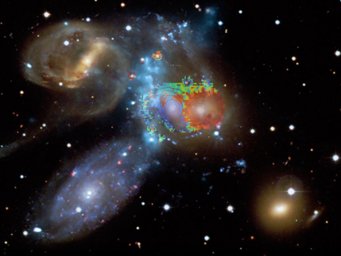New spectrograph's first light promises insights into galactic archaeology, origin of chemical elements
First scientific observations with the new spectrograph WEAVE, on La Palma, have provided an impressive example of the instrument's capabilities. At the Max Planck Institute for Astronomy, which provides part of the instrumentation project's funding, Maria Bergemann is looking forward to using WEAVE for systematic studies of the archaeology of our home galaxy, and for a survey of chemical elements in our galaxy.

WEAVE, a new spectrograph at the 4.2 meter William Herschel Telescope at the Observatorio del Roque de los Muchachos, La Palma, Canary Islands, has delivered first science data ("first light") observations. The acronym WEAVE stands for "William Herschel Telescope Enhanced Area Velocity Explorer."
For "first light," the team chose to focus on the galaxies NGC 7318a and NGC 7318b, which are part of a galaxy group called Stephen's Quintet, 280 million light-years from Earth, in the Northern constellation Pegasus. WEAVE measured spectra for 547 regions in and around those two interacting galaxies. Via the so-called Doppler effect – light shifting to slightly longer or slightly shorter wavelength depending on how fast matter is moving away from us or towards us, respectively – it allows astronomers to reconstruct the motion of gas in the observed regions. This information will be used to reconstruct the details of how the two galaxies are colliding.
Galactic archaeology with detailed spectra
Maria Bergemann, a group leader at the Max Planck Institute for Astronomy (MPIA, which is contributing funding to the instrument), is looking forward to using WEAVE to explore our home galaxy, the Milky Way. Since 2013, ESA's Gaia mission has revolutionized astronomy, providing high-quality position data, motion data, and low-resolution spectroscopy for hundreds of millions of objects within our galaxy. This has opened up the possibility of systematic studies of our home galaxy's structure and evolution. Surveys like those that are possible with WEAVE complement Gaia data by producing high-resolution spectra. WEAVE provides valuable additions to previous surveys of this kind, such as the Gaia-ESO survey that had focused on the Southern sky.
Maria Bergemann says: "WEAVE will enable unprecedented studies of the Galaxy, especially in the regions of the outer disc and deep halo that have not been accessible with any other comparable 4-meter class facility to date." In addition to taking part in the WEAVE Galactic Archaeology program, Bergemann will also use data from WEAVE to study the origin of chemical elements heavier than iron in our home galaxy – a research project for which she recently obtained an ERC Starting Grant.
Probing multiple objects, or regions, in parallel
Spectrographic instruments such as WEAVE provide key information for astrophysics. A spectrum, that is, the rainbow-like decomposition of light from a celestial object, typically encodes information about the object's motion, chemical composition, temperature, gas densities and more. WEAVE has different modes for taking numerous such spectra in parallel. In the mode that was used for the "first light" observations, 547 glass fibres, each of which conducts light from one specific region to the spectrographs, provide a "spectral image" of the central part of the telescope's field of view. Such "integral field" spectroscopy is similar to taken an ordinary image, with the image information contained in separate pixels – except that in this case, each separate pixel has a full spectrum, from ultraviolet to near-infrared!
In the "multi-object spectroscopy" mode, each glass fibre is placed on a different object within the field of view, with a total of up to 960 separate spectra taken. As an example, this mode could be used to take high-resolution of 960 different stars that are visible in the telescope's field of view. The third mode uses up to 20 bundles, each bundle consisting of 37 fibres, and providing spectroscopic information for a small region within the field of view.
Background information
WAVE is administered by the Isaac Newton Group of Telescopes (ING). The instrument was built by a consortium of European astronomical institutions, led by the UK Science and Technology Facilities Council, to become the next-generation spectroscopic facility for the William Herschel Telescope on La Palma. The Max Planck Institute for Astronomy is one of more than 20 institutions that provide funding for WEAVE.
